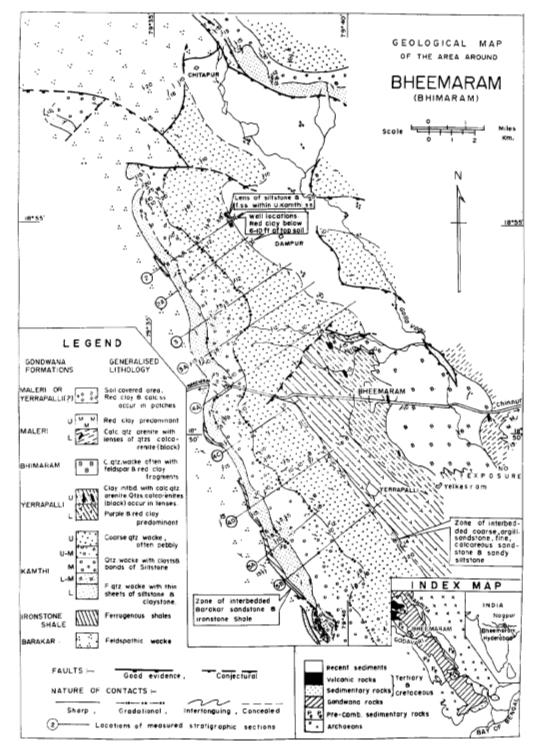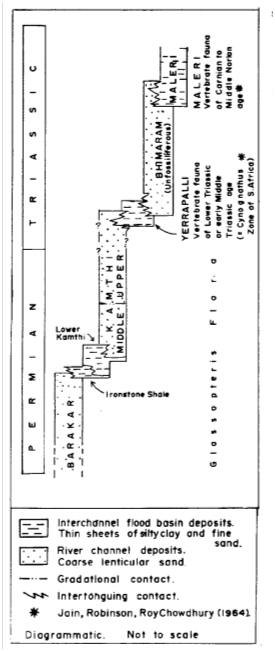Yerrapalli Fm
Type Locality and Naming
Pranhita-Godavari Basin: The type area lies between Yerrapalli and Madakellu. Jain et al. (1964) differentiated it as distinct unit of the Maleri 'stage' of King (1881). Sengupta (1966) and Chatterjji (1967 a, b) distinguished it as a separate formation. Named after Yerrapalli village, Telangana. [Original Publication: Jain, S.L., Robinson, P.L. and Roy Chowdhury, T.K., 1964. A new vertebrate fauna from the Triassic of the Deccan, India. Quart. Jour. Geol. Soc. Lond., 120 (1), no. 477, 115-124; King, W. 1881. The geology of the Pranhita-Godavari valley. Mem. Geol. Surv, Ind., 18(30), 150-311; Sengupta, S. 1966. Palaeocurrent and depositional environments of the Gondwana rocks around Bheemaram-a preliminary study. Bull. Geol. Soc. Ind., 3(1), 5-8; Chatterjee, S., 1967. New and associated phytosour material from the upper Triassic Maleri formation of India. Bull. Geol. Soc. Ind., 4, 108-110; Chatterjee, S., 1967. New discoveries contributing to the stratigraphy of the continental Triassic sediments of Pranhita-Godavari valley. Bull. Geol. Soc. Ind., 4(2), 37-41.]
[Figure 1: Geological map of Bheemaram area, Telangana (adopted from Sengupota, 1970)]
Lithology and Thickness
Sandy claystone. This formation is essentially red clay formation with subordinate sandstone. It consists of thin sheets of red and purple clay at the bottom and fine grained poorly sorted sandstone with plenty of clay matrix on its upper surface (Sengupta, 1970). The associated rock types include 'lime pellet' rocks, fine-grained, whitish, calcareous sandstone, medium to coarse-grained grey white feldspathic calcareous sandstone and black calcareous sandstone (Sengupta, 1970; Chatterjee, 1967; Sastry et al., 1977; Peter, 2009).
[Figure 2: Stratigraphic relation between Gondwana formations around Bheemaram (adopted from Sengupta, 1970)]
Relationships and Distribution
Lower contact
The formation has conformable and gradational contact with the underlying Kamthi Fm.
Upper contact
The formation has conformable and gradational contact with the overlying Bheemaram Fm.
Regional extent
Pranhita-Godavari Basin: The Yerrapalli Formation has been traced from the type area section 40 km NW-SE from Nimbala to Kamanpalli with northerly dips (Chatterji, 1967a, b)
GeoJSON
Fossils
The fauna includes: Fishes: Ceratodus sp. (Chatterjee, 1967), Sauricthys sp. (Jain, 1984); amphibian: Paratosuchus (Stanocephalosaurus) rajareddyi (Roy Chowdhury, 1970a; Scoch and Milner, 2000); Reptiles: Wadiasaurus indicus (Roy Chowdhury, 1970b; Bandyopadhyay, 1988), Rechnisaurus cristarhynchus (Roy Chowdhury, 1970b; Bandyopadhyay, 1989), Mesodapedon kuttyi (Chatterjee, 1980), Pameleria dolichotrachela (Sen, 2003), Yarasuchus deccanensis (Sen, 2005), Trirachodontidae indeterminate trirachodontid (Chatterjee et al., 1969) and erythrosuchid (Bandyopadhyay, 1999).
Age
Depositional setting
The mudstones were deposited across a floodplain, whereas lenses of calcareous sandstone represent ephemeral streams that branched off from the larger channels that were the source of the floodplain sediments. The climate of the region during the time is thought to have been monsoonal with both wet and dry seasons (Bandyopadhyay, 1988; Sues and Fraser, 2010).
Additional Information
References
Bandyopadhyay, S. (1988). A Kannemeyeriid Dicynodont from the Middle Triassic Yerrapalli Formation. Philosophical Transactions of the Royal Society B: Biological Sciences. 320 (1198): 185–233. Bandyopadhyay, S., 1989.The mammal-like reptile Rechnisaurusfrom the Triassic of India. Palaeontology 32 (2): 305–312. Bandyopadhyay, S. (1999): Gondwana vertebrate faunas of India. PINSA 65 A (3): 285-313. Chatterjee, S., 1967a. New and associated phytosour material from the upper Triassic Maleri formation of India. Bull. Geol. Soc. Ind., 4, 108-110. Chatterjee, S., 1967b. New discoveries contributing to the stratigraphy of the continental Triassic sediments of Pranhita-Godavari valley. Bull. Geol. Soc. Ind., 4(2), 37-41. Chatterjee, S. 1980 Chatterjee, S., Jain, S. L., Kutty, T. S., and Roy Chowdhury, T. K. 1969. On the discovery of Triassic cynodonts from India: Science and Culture, 35: 411. Dasgupta, K. (1993 Jain, S.L., 1984. A new Triassic fish (Actinopterygii: Saurichthiformes) from Yerrapalli Formation, Pranhita–Godavari Valley, India. Journalof the Geological Society of India 25 (9), 604–610. Jain, S.L., Robinson, P.L. and Roy Chowdhury, T.K., 1964. A new vertebrate fauna from the Triassic of the Deccan, India. Quart. Jour. Geol. Soc. Lond., 120 (1), no. 477, 115-124. King, W. 1881. The geology of the Pranhita-Godavari valley. Mem. Geol. Surv, Ind., 18(30),150-311; Peter, J. 2009 Roy Chowdhury, T. K. 1970a. A new capitosaurid amphibian from the Triassic Yerrapalli Formation of the Pranhita-Godavari Valley. Journal of the Geological Society of India, 11: 155-162. Roy Chowdhury, T. K. 1970b. Two new dicynodonts from the Yerrapalli Formation of Central India. Palaeontology 13:132-144. Sastry et al., 1977 Schoch R. and Milner, A.R. 2000. Stereospondyli. Handbuch der Paläoherpetologie – Encyclopedia of Paleoherpetology 3B: 1-203 Sen, K. 2003. Pamelaria dolichotrachlea, a new prolacertid reptile from the Middle Triassic of India. Journal of Asian Earth Sciences, 21: 663-681. Sen, K. 2005. A new rauisuchian archosaur from the Middle Triassic of India. Palaeontology, 48: 185-196. Sengupta, S. 1966. Palaeocurrent and depositional environments of the Gondwana rocks around Bheemaram-a preliminary study. Bull. Geol. Soc. Ind., 3(1), 5-8. Sengupta, 1970 Sues, H.-D.; Fraser, N.C. (2010). Early and early Middle Triassic in Gondwana. Triassic Life on Land: The Great Transition. New York: Columbia University Press.

